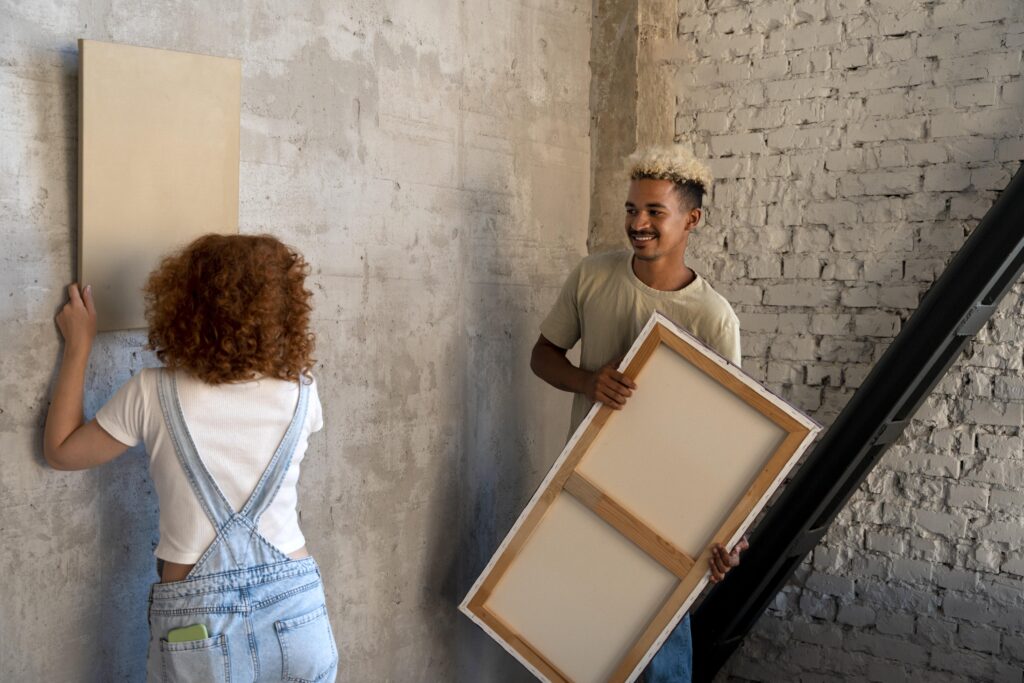
Storing artwork requires careful planning to prevent damage and ensure its preservation, especially if you’re using a storage unit. Here’s a comprehensive guide to help you understand how to store art safely and securely:
1. Climate Control is Crucial
When selecting a storage unit for your artwork, prioritize climate-controlled storage units. Temperature and humidity fluctuations are the primary causes of damage, such as mould growth, warping, and fading. The ideal temperature range for how to store artwork is between 68°F and 72°F, with humidity levels kept between 40% and 50%. Avoid attics, basements, or garages, where these conditions are harder to maintain, as inconsistent environments can rapidly degrade your collection.
2. Use Proper Packing Materials
The right packing materials are essential for protecting your artwork during storage. Here are some tips for different types of artwork:
a. How to store paintings:
Wrap them in acid-free paper and bubble wrap. Sturdy cardboard or specialized art storage boxes provide extra protection. Use corner protectors to safeguard frames from damage.
b. How to store framed artwork:
Secure glass-framed art with foam or cardboard and avoid stacking pieces directly on each other. Wrapping them in plastic can also prevent dust and moisture buildup.
c. How to store paper artwork:
Store flat between acid-free boards or in archival-quality sleeves to prevent curling, tearing, or yellowing.
3. Store Artwork Vertically
For large paintings and framed artwork, always store them vertically to avoid pressure or damage. Directly placing them on the floor can result in bending or other forms of degradation over time. Shelving or storage racks help to keep artwork separated and upright, reducing the risk of accidental contact that might cause scratching or other harm.
4. Avoid Sunlight Exposure
Prolonged exposure to direct sunlight can fade or discolour artwork. Always store your pieces in a dark space, ideally in opaque or light-blocking covers. If you must store artwork near windows, ensure that it is fully covered or stored in a container that shields it from light.
5. Label and Inventory Your Collection
Create a detailed inventory of your stored artwork. Label each piece with its title, artist, dimensions, and any relevant notes. Taking photos of your collection before storage provides a useful reference and can be vital for insurance claims if damage occurs. This step helps you track your items, especially in large collections.
6. Professional Art Storage Options
If your collection includes high-value or irreplaceable pieces, consider storing them in a specialized art storage facility. These facilities offer superior temperature and humidity controls, heightened security, and expert handling, ensuring your artwork is well-preserved and secure.
7. Use Archival-Quality Materials
Archival-quality, acid-free materials should be used for any long-term storage. Acidic materials, such as standard paper or cardboard, can degrade over time, causing yellowing or other damage to your artwork. Whether storing prints, photographs, or other delicate pieces, be sure to use acid-free paper, sleeves, and boxes.
8. Protect Against Dust and Moisture
Ensure all your artwork is properly wrapped and sealed to protect it from dust, debris, and moisture. Using silica gel packets in storage boxes can help absorb excess moisture, reducing the risk of mould or mildew. Regularly inspect your self-storage units for cleanliness and moisture levels to keep your art in optimal condition.
9. Regular Inspections
Periodically inspect your stored artwork to identify any potential issues early. Look for signs of pests, mould, or damage due to environmental changes. Catching these problems early allows for timely intervention, helping to preserve your collection for years to come.
10. Secure High-Value Art
For particularly valuable artwork, additional security measures, such as using tracking devices or utilizing professional art storage with 24/7 monitoring, provide extra peace of mind. These specialized storage solutions help mitigate risks associated with theft, vandalism, or environmental hazards.
By following these best practices, you can ensure your artwork remains in pristine condition during storage, whether for short or long periods. If you’re in need of secure, climate-controlled storage solutions, Moishe’s Self Storage offers the perfect environment to protect your precious art collection.
Frequently Asked Questions
How to store framed art long-term?
Store framed art in a climate-controlled space, using acid-free wrapping materials. Ensure each piece is stored upright to avoid pressure damage and keep it away from direct sunlight.
How to wrap paintings for storage?
Use bubble wrap, acid-free paper, and corner protectors. Ensure each piece is snugly packed in a sturdy box with ample padding to prevent movement during transport or storage.
How to pack paintings for storage?
Ensure that each painting is wrapped with care using appropriate materials, including foam or bubble wrap for protection. Sturdy boxes with padding are recommended for secure transport or long-term storage.
Where do artists keep their artwork?
Many artists store their artwork in climate-controlled studios or specialized art storage facilities to ensure the longevity of their pieces. These spaces help maintain ideal temperature and humidity levels.
Can I store artwork in a regular storage unit?
It is not recommended. Regular storage units lack temperature and humidity control, which can lead to damage over time. Climate-controlled units are essential for proper artwork preservation.
